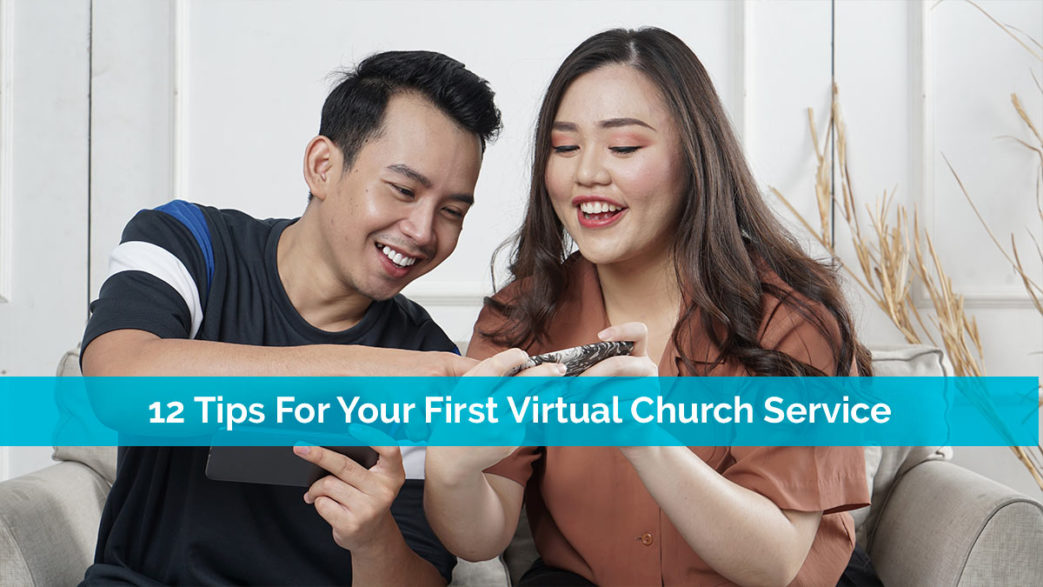More and more churches are adding virtual services. It’s a convenient way to reach your church family when everyone can’t be together. While it will take some planning, hosting your first virtual church service is an exciting time.
At first, it might seem intimidating. You have quite a few decisions to make and some logistics to work out. Giving your members another way to attend when they’re sick, or in the event of COVID-19, quarantined, is well worth the work.

1. Test Everything First
Even the best laid plans can go awry. Most often, the biggest obstacle churches run into is their equipment doesn’t work when it’s time to go live. Typically, it’s something simple, such as a cable was disconnected or a setting wasn’t in place.
The great news is this is actually easy to fix. While you may test things out when you first set up your equipment, you might not test it before you go live. Just because something worked a few days ago doesn’t mean it’ll work correctly now.
To be certain everything is working, test things out with a few volunteers. Make sure they can see and hear you. If you have people helping you out, make sure they’re able to interact as well and change settings as needed, such as muting and switching to different cameras.
2. Practice In Front Of A Camera
This one might sound silly, but a virtual church service is different than what you’re used to. Whether you have members in church or you’re going completely virtual, a camera changes things. Suddenly, part or all of your listeners are somewhere else.
You can’t interact with them the way you can when you see their faces in person. Even if you’re using a platform where participants can see each other, it’s still not quite the same.
It’s a proven fact that stepping in front of a camera can cause stage fright. Yes, you might be used to stepping in front of your church every Sunday, but a camera is an unknown. Your audience doesn’t feel quite the same. Don’t worry, though, you will get past this after a few virtual services.
However, you need to practice a little before you actually go live. Ask a small group of members to help you out. Volunteers or church staff may be happy to help serve as a practice audience.
If you do start to feel nervous as you’re getting started with your first virtual church service, try to interject a little humor. It’s also a good idea to have someone else in the room or chiming in from another room or their own home to speak up to ease any tension if you’re struggling with camera fright.
3. Market The Virtual Church Service
You’re hosting your first virtual church service, but does anyone know about it? For those who do know, do they know how to view it?
You’d be surprised at how many people don’t attend simply because they’re not sure how. Others completely forget about it. It’s up to your church to market the service and make it as easy as possible for everyone who wants to attend to view it.
You can always market it at the end of regular services. However, it’s also a good idea to hand out a piece of paper with instructions on how to access the virtual service.
If you’re dealing with social distancing or members are out sick, you’ll need to do a little extra marketing, such as:
- Text members
- Blog about it
- List it as an event on your church home page and event page
- Talk about it on social media
- Send it out as part of your church’s email newsletter
One thing to remember is it might not be just your members who attend virtual services. People who follow your church on social media or visit your website regularly may also want to attend.
When marketing your virtual church services, list both the date and time. Also, explain what platform you’re using and what viewers will need in order to participate.
Most importantly, keep reminding people. If you post once on social media a week before you go live, people might forget. Post a few days before, the day before and the day of. Once you start a regular schedule, people are more likely to remember and they’ll share the details with othes.

4. Don’t Do It Alone
There’s this common misconception that a virtual church service is as simple as grabbing a phone and filming yourself. While that can work, it’s not easy. Just think about how tired your hand will get holding the phone. Plus, what happens if something’s not working right?
You shouldn’t try to do a virtual service all on your own. Instead, put together a small team. The good thing is your team doesn’t even have to be in the same room.
A few things you might need help with include:
- Technical difficulties, such as things not loading right or the mic not working
- Adjusting the sound, especially if you’re using a microphone outside of your phone or computer
- Muting viewers if you’re using a video-conferencing style platform
- Unmuting viewers when they’re able to ask questions
- Handling music, if any
- Helping with pre-service testing
- Someone to help answer questions before the service, such as tech-related or feature-related questions
- Ensuring images show up, such as PowerPoint slides of Bible verses
It’s also a good idea to have a backup person. If you start coughing uncontrollably or find yourself suddenly terrified in front of the camera, your backup can switch the camera to themselves and take over until you’re ready.
5. Warn Viewers Of Possible Hiccups
Never in the history of technology has something launched perfectly the first time. No amount of planning will guarantee a perfect first virtual church service.
You’ll likely be fiddling with settings and equipment throughout the broadcast. You’ll struggle to find the right balance of interaction and trying to respond to viewers. The sound might cut in and out or the video may get blurry at times.
This is all perfectly natural, especially if you’re trying to learn to do all of this in a hurry. Be upfront with your viewers. Let them know to expect some hiccups and to please be patient as you work through them. Also, ask them to tell you if something’s not going right.
Overall, your service will likely go fairly smooth. Just don’t be disappointed over a few minor issues. Make a note of them to help avoid them next time.
6. Get Viewers Involved
A virtual church service shouldn’t just be one person talking. Instead, make it interactive. Even though it’s virtual, doesn’t mean you can’t have a sense of community.
Set up your service to give viewers opportunities to participate. Stop to ask questions. Answer questions. Give viewers a chance to sing, if your platform allows for it. You can even have time to socialize before and after.
The ways viewers interact depends on the platform you’re using. For example, if your live streaming on Facebook, viewers can use reactions and comments to participate. If you’re using Zoom, they can speak up to ask questions or comment when you open up the mics for everyone.
Usually, there’s at least some type of chat feature available. If not, ask your viewers to jump on Facebook and have a single post for interacting. Have a team member monitor the post and highly questions or comments you should address. More interactions make it seem more normal and less virtual.

7. Talk To People, Not The Camera
If you’re hosting your service in an empty room, it’s easy to feel more like you’re talking to yourself than a group of people. When you have people in front of you, it’s easy to play off of their emotions and facial expressions. You tend to be more animated and adjust your voice to elicit bigger responses.
Do the exact same thing when you’re in front of the camera. Try to avoid sounding monotone, bored or even sad. Give your virtual services your all. If you feel more comfortable standing and moving around, do so as long as you stay in the frame. If it’s easier to sit down, do that, but let your face and voice express emotion.
You’ll draw people in more and make them feel like you’re talking to them and not just a camera.
8. Get Social Before The Service
Start socializing with viewers before the actual service. Some churches use video conferencing tools for group chats before services. Others opt to use social media or even a chat feature on their church website.
The idea is to provide something similar to the same socialization that typically goes on before services start in church. People say hello, ask how people are and chit chat. You can still do this, but in more virtual format.
Plus, getting conversations started early gets people excited about the service. It also gives them time to remind others so they can jump in too.
9. Pick A Platform Everyone Can Use
This is the hardest part. Odds are, you’re not going to find a platform that everyone already uses. In fact, some of your members may have never video chatted or streamed anything. The key is to pick something that’s widely available to everyone.
While you can’t exactly fix Internet issues, such as some members not having access to broadband, you can assist members in installing a new app or tool to view services online. If possible, ask members to vote on what apps/tools they would rather use.
Ideally, pick platforms that are free for your viewers. While you might use a paid service, ensure viewers can watch for free. Some platforms you might consider include:
- Facebook Live
- YouTube Live
- Zoom – Best for small groups up to 100 people and 40-minute meetings. Premium plans with fewer limits start at $15/month.
- Skype
We’ve also put together a list of live streaming companies for sermons. All of the options allow viewers to join in for free.

10. Figure Out Your Music
This is where things might start to get tricky. Playing some music in the background won’t work as well as you might expect. Your mic isn’t going to pick up the sound clearly.
Another issue you have to think about is copyrights. You may have the rights to play and sing music in your church, but when you start broadcasting it, there could be issues. It’s better to stick with royalty-free music. You buy it once and can use it in all your church videos. Some services let you pay a monthly fee to access their entire catalog of music.
Some great sites to find royalty-free music for your virtual church services include:
- Soundstripe – $11.25/month for entire catalog
- Free Music Public Domain – Free
- Storyblocks – $12.50/month for unlimited downloads
- Marmoset – Pricing varies, but you can get custom music
You can also use any public domain hymns, such as those listed on Hymns Unto God and The Open Hymnal Project, though some arrangements aren’t public domain. Naturally, if your church has original music, that’s always fine to use.
The next step is how to provide the music. You can switch to a small live band, a choir or even several people in their own homes playing together. Ask your viewers to sing along, even if you’re not on a platform where everyone can hear each other.
11. Plan Out The Service Itself
Much like any other service, you need to plan out your first virtual church service. In addition to your sermon, plan out:
- When you’ll have music
- When to pause for viewer interactions
- How to interact before and after services
- How long the service should be (remember some people may have limited data available)
- What visuals to use, such as slides or pictures
The better prepared, the smoother everything will go.
12. Continue Conversations Afterwards
Who doesn’t like socializing after services? Once the virtual service is over, don’t end it completely. If people want to keep chatting or asking questions, let them. Set a time limit for socializing, such as 30 minutes to an hour after the service ends. This makes everything feel more normal and keeps your church family better connected.
Have a Facebook page for people to continue connecting throughout the week. Also suggest that smaller groups get together on Zoom or Skype to video chat and continue with smaller ministry groups.
Don’t forget to continue providing great worship resources on your church website. If you need a church website or your’s needs an upgrade, contact us today.




